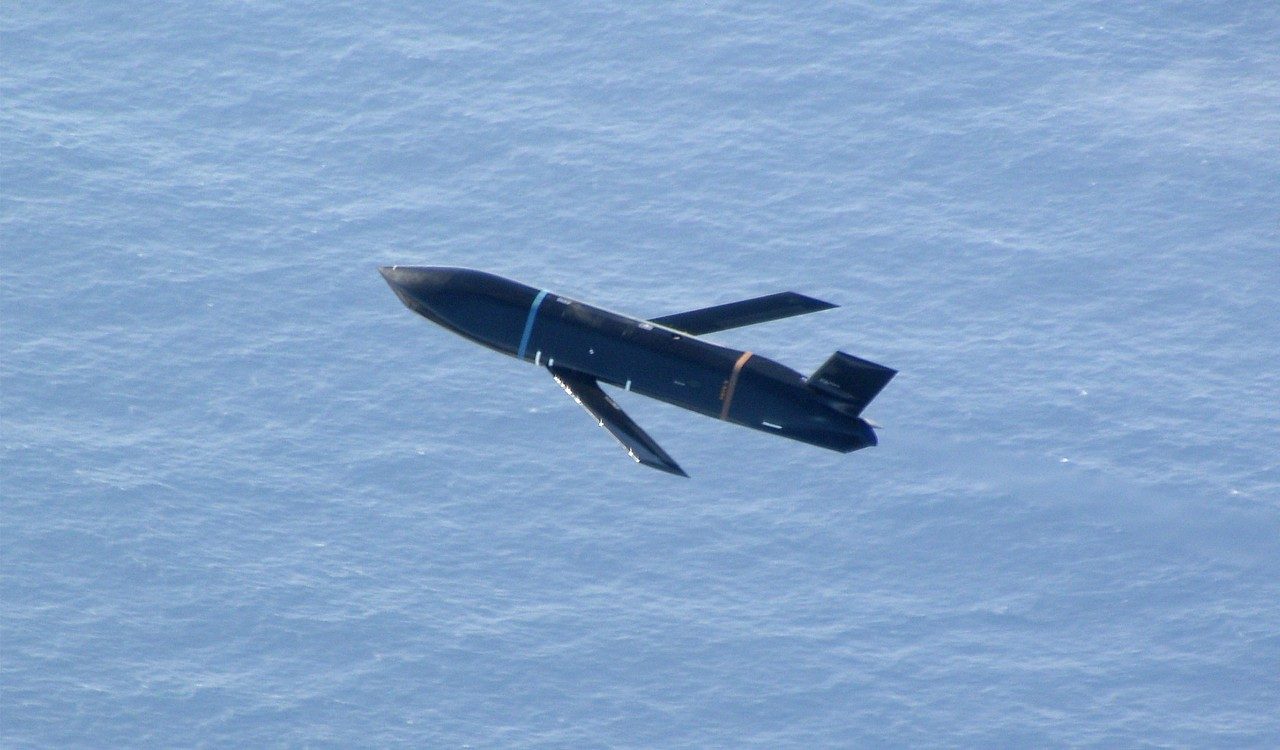Faced with burgeoning threats from rivals like China and Russia, the United States is boosting its air-launched missile capability with new orders.
The Pentagon awarded a fresh set of contracts totalling approximately $7.8 billion on July 31 to boost the supply of AGM-158 Joint Air-To-Surface Standoff Missile (JASSM), AGM-158C Long-Range Anti-Ship Missile (LRASM), and the AIM-120 Advanced Medium Range Air-to-Air Missile (AMRAAM).
Lockheed Martin received the lion’s share of the total $7.8 billion earmarked for missiles. The $4.3 billion contract signed with this defense giant also includes missiles that will be delivered to allies like Poland, the Netherlands, Japan, and Finland.
The DoD notification also stated that the current round of awards was a modification of an existing deal, increasing the contract’s cumulative value to around $9.5 billion.
“Increasing JASSM and LRASM production is essential for American and allied national security, and Lockheed Martin is ready to answer the call,” Dave Berganini, vice president of hypersonic and strike systems at Lockheed’s Missiles and Fire Control division, said.
“We are leveraging our advanced manufacturing capabilities and investing in our production facilities to quickly and affordably deliver these critical capabilities warfighters need to maintain a strategic edge and protect our nation from emerging threats.”
Notably, the purchases of munitions coincide with the Pentagon’s efforts to restock and replenish its missile arsenal, which has been strained by Middle East conflicts and repeated supplies to Ukraine. According to officials, a sizable stockpile of munitions will also be required to deter China, which is seen as the biggest security threat at this point.
There is currently no information on the number of JASSM and LRSAM that the contract covers. However, we know that the Pentagon is taking a multi-year procurement approach when it comes to these missiles.
According to Air Force papers, the service’s 2025 budget, which was the first in the multiyear procurement deal, included funding for 115 LRASMs and 450 JASSMs.
From BVR Missiles To Stunning Shootdown Claims — Who Held The Edge In India-Pakistan War? OPED
The 2026 budget request is expected to use a combination of the base budget and newly approved reconciliation monies from Congress to fund 389 JASSMs and 118 LRASMs, as noted by the Air and Space Forces Magazine report.
Lockheed Is Working To Boost US Firepower
Joint Air-to-Surface Standoff Missile (JASSM)
These long-range missiles will bolster the firepower of the US Air Force and the US Navy and help deter adversaries like China in the volatile Indo-Pacific region.
The Joint Air-to-Surface Standoff Missile (JASSM), for one, is a long-range, stealthy, precision-guided, air-launched cruise missile developed by Lockheed Martin. It is designed to destroy high-value, heavily defended targets such as enemy command centers, air defenses, infrastructure, and military installations. The JASSM has a range of over 300 kilometres, and its extended-range variant, the JASSM-ER, has a range of 925 kilometers.
With its vertical tail and flip-out wings, the JASSM comes equipped with a blast fragmentation warhead and dual-mode penetrator. The missile weighs about 1,000 kilograms and can carry warheads weighing up to 450 kilograms.
The infrared seeker with Automatic Target Correlating algorithms of this missile enables precise strikes on hardened or moving targets. Moreover, unlike traditional cruise missiles that fly low to avoid detection, JASSM’s stealth allows higher-altitude flight for extended range, avoiding terrain-following energy costs.

The JASSM can be launched from a host of aircraft in the US inventory, including the B-1B, B-2, B-52, F-16, F-15E, and F/A-18. Additionally, it is being integrated into the fifth-generation F-35 Lightning II aircraft. Thus, providing a stealth-on-stealth capability as the US military accrues capabilities against near-peer adversaries in China.
A stealth fighter armed with a stealth cruise missile might be able to strike assets deep inside the enemy territory, as previously explained by the EurAsian Times. It would essentially offer a reliable way to attack critical enemy targets at standoff ranges, such as taking down or weakening an adversarial anti-access/area denial (A2/AD) network.
By enabling strikes from beyond enemy air defense ranges, the JASSM would also reduce risks to pilots and aircraft, preserving valuable assets like the stealthy and very expensive F-35 Lightning II. This will be extremely vital in high-threat environments where adversaries deploy advanced radar and missile systems, such as the Chinese coastline.
The missile has reportedly been used in the past with a high degree of success in Syria and Afghanistan. Additionally, the US has been mulling the possibility of arming Ukraine with the JASSM missile.
These missiles, capable of being launched from the Ukrainian F-16 fighter jets, would significantly boost Ukraine’s ability to strike strategic targets deep behind Russian lines.
While the US has not taken an affirmative decision yet, the momentum has been building to arm Kyiv with these lethal missiles to deal a blow to Russia as tensions continue to mount and President Putin refuses to end the war.
Long-Range Anti-Ship Missile (LRASM)
The other missile that the US is buying—the LRASM—is a ship-launched variant of the JASSM. It has been designed to lead the way in developing more advanced autonomous targeting capabilities than the US Navy’s Harpoon anti-ship missile, which has been in use since 1977 and is fast approaching obsolescence.
In particular, the missile’s design prioritizes survivability. This intelligent anti-ship missile is precision-guided and can intercept various surface threats while delivering a precise payload from a safe, stand-off distance.
The LRASM has a minimum range of 200 nautical miles (more than 370 kilometers), and it can be used to target land-based targets, aircraft, hostile ships, drones, and even shallow submarines. The missile navigates to its target in semi-autonomous mode.
In hostile electronic warfare environments, the LRASM’s advanced guidance operation enables the weapon to locate and destroy its pre-defined target using gross target cueing data, eliminating the need for GPS navigation, network links, and ISR (intelligence, surveillance, and reconnaissance) platforms.
More significantly, during its terminal flight phase, the missile uses a passive imaging infrared sensor. This sensor is immune to jamming and avoids enemy radar detection by visually identifying and striking the target’s most vulnerable spots.
The missile is anticipated to be one of the most crucial US weapons against China in a potential conflict that could be triggered by an invasion of Taiwan or during a conflict in the South China Sea. Long-range weapons will be crucial in the early stages of the conflict because China has strong anti-access and area-denial capabilities throughout the First Island Chain, which encompasses sections of Indonesia, Japan, Taiwan, and the Philippines.

In addition, for the US to launch attacks from outside China’s air defense envelope, the troops would rely on bomber-launched cruise missiles because they cannot get close to the Chinese fleet or resupply ground forces in Taiwan.
By using LRASMs, US fighters and bombers will be able to strike high-priority maritime targets, such as aircraft carriers and warships. Moreover, the missiles will be crucial to carry out combat operations in both the open ocean and coastal waterways due to their long-range tactical strike recognition and delivery capabilities.
The missile is compatible with B-1B, B-52H Stratofortress, F/A-18E/F Super Hornet, P-8A Poseidon, F-35 Lightning, and now the F-16 Viper, as reported by the EurAsian Times.
There is an indication that this long-range missile was used against the Yemen-based Houthis. A May 22, 2025, DoD reprogramming document states that funds were needed to replace LRASM C-3 All Up Rounds (AURs) “expended in support of the DoD response to the situation in Israel.”
This means that the LRASM may have been used in operations linked to the Israel-Houthi conflict, potentially targeting Houthi assets or threats in the Red Sea.
AMRAAMS Also On Order
The Pentagon and Raytheon inked a record-breaking $3.5 billion deal for the procurement of AIM-120 Advanced Medium-Range Air-to-Air Missiles (AMRAAM), telemetry systems, spare parts, and maintenance. The order includes missiles to be sold to 19 countries, including Japan, Germany, Poland, Australia, the UK, Israel, and Ukraine.
At $3.5 billion, the AMRAAM contract is the largest agreement ever signed by the program. The purchase coincides with rising international tensions and the depletion of the current AMRAAM arsenal. “As global conflicts intensify and air threats become more sophisticated, AMRAAM continues to give allied forces a decisive edge in combat,” Sam Deneke, president of air and space defense systems at RTX unit Raytheon, said in a statement.

“This award underscores the critical role that the fifth-generation AMRAAM plays in maintaining air superiority and will ensure service members have the advanced technology needed to stay ahead of adversary threats,” he added.
Every fighter in the US inventory and those of the majority of allies are capable of carrying them. They have also been employed as surface-to-air missiles (SAMs) in the National Advanced Surface-to-Air Missile System (NASAMS).
Additionally, the US deployed the AMRAAMs extensively to defend Israel from numerous Iranian strikes, including against Houthi drones and drones over Syria and Iraq.
The US is currently working on developing the AIM-260 very-long-range missile. However, the threat of an air-to-air conflict with a near-peer adversary like China means that the AIM-120 will remain a key weapon for eliminating any air-breathing target for many years to come.
Moreover, as the conflict between Russia and Ukraine intensifies, the latter is likely to need more of these missiles to hold fort against Russian missile barrages.
The need to increase production is more urgent than ever.
- Contact the author at sakshi.tiwari9555 (at) gmail.com
- Follow EurAsian Times on Google News




